TURNING LEBANESE
There’s so much more to Lebanese cuisine than falafels, hummus and pita bread
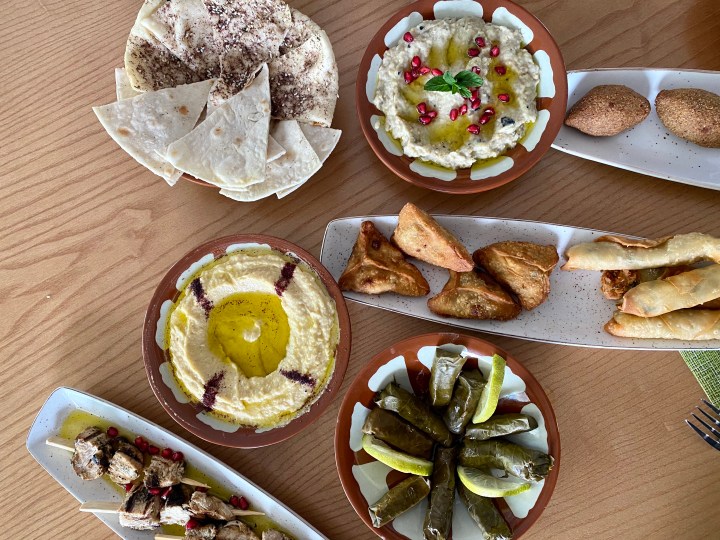
While these are indeed staples of the Levant region where Lebanon is bordered by the Mediterranean Sea to the west, Israel to the south, and Syria to the east and north, the generous nature of feasting with family and friends will see multiple dishes on the table.
In Sophia Lindop’s book Going Home, the recipes serve many. Labneh, eight to 10; pickled turnips, a two-litre jar; a recipe for fruity baklava samoosas yields 50; chicken with saffron, green olives and preserved limes, eight to 10. There are quite a few that serve six, but singles and couples are either going to have to adapt or be prepared to eat leftovers. Or invite friends over.
Having had two separate experiences of Lebanese meals for this story, I completely buy into the concept of a table groaning under varied dishes. On Every Culture on the internet I found: “Eating in Lebanon is tied to family: people almost never eat alone. The Lebanese consider eating out a social and almost aesthetic experience.”
Lindop is of Lebanese descent, born and raised in South Africa, where her great grandparents immigrated in the late 1800s. Going Home not only provides wonderful recipes, beautifully styled by Hein van Tonder, but the story of how she eventually returned to the land of her ancestors, and her adventures there.
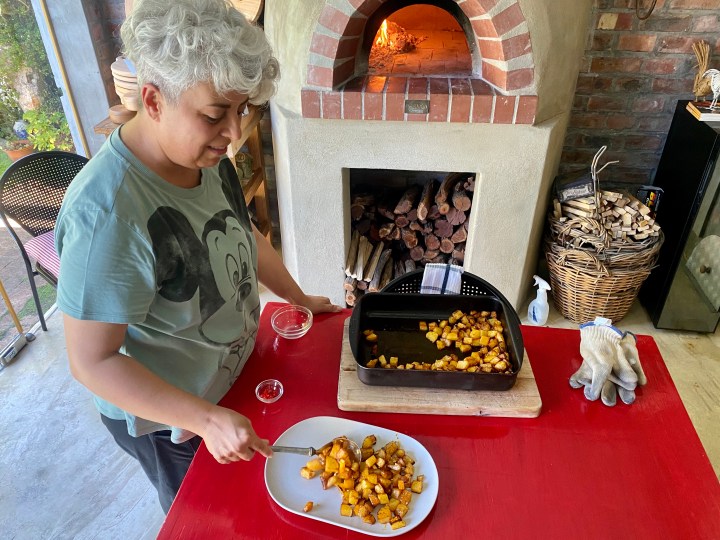
Batata harra finished in the wood oven, dished up by Sophia Lindop. (Photo: Bianca Coleman)
Part of a small group, I was at Lindop’s house in Cape Town’s southern suburbs on a Saturday morning for a cooking class. Before we headed to the kitchen, Lindop told us this tale.
Her grandfather had unpleasant childhood memories so when Lindop would ask him to teach her to speak Arabic (which he and her grandmother spoke to each other), he refused, saying she must speak English and Afrikaans. When she asked about Lebanon, he dismissed her, telling her South Africa is her home.
“But there were moments…,” said Lindop. “I was his favourite grandchild and I can say that unequivocally. He called me Queenie. He was a medical doctor and he also wrote books about his experiences in the Platteland. I used to stay over and when he came home from delivering babies and sewing up wounds, or whatever, he’d wake me.
“We’d go into his tiny office with a desk, two chairs, a lamp and an Olivetti typewriter. He had the most beautiful handwriting – his patients would frame his prescriptions – and my job was to read the manuscripts he’d handwritten and he’d type them out with two fingers to send to the publishers.
“There was always a moment, normally around two o’clock in the morning, when he would stop and say I must go to the fridge and cut us some halva – my granny always imported a block – which we would have with black coffee. While we were eating and drinking I’d ask questions about Lebanon and I had snippets, puzzle pieces which I couldn’t put together.
“So when I finished school – I was the only daughter – I said to my dad, ‘I’m going to Lebanon’ and he said ‘over my dead body’.”
Then, as it is wont to do, life happened. Lindop worked, married Paddy, a dentist, and next thing she knew she was approaching 50. “I thought damn it, if I don’t go now…,” she said. Flights were booked for her, Paddy, her father and her stepmom to travel in July 2017. In August, Dad was diagnosed with terminal cancer. “The night he passed away I made him a promise I’d go back, and he cried,” said Lindop. “I’ve been back so many times since. It’s my happy place. I found my family, and in this process met chefs, guest house owners and hoteliers, and started working in kitchens. And started learning.”

Carrots with spicy harissa yoghurt. (Photo: Bianca Coleman)
A lot of people in South Africa have an image of Lebanese food, said Lindop; it is but a minute fraction of what there is. By way of explanation, she describes the country’s topography. “I remember the old people always tell this story that you can ski on the mountain in the morning and swim in the sea in the afternoon. It’s true. Lebanon is 227km long, utterly beautiful. At its widest, it’s only 80 km. It’s cut in half by Mount Lebanon, 30 km from the ocean.
“Imagine the food, it’s completely diverse,” she said. “In the mountain, which is covered by snow for most of the year, it’s heavier, stodgier, meatier; at the ocean it’s seafood, salads, light, beautiful. So my eyes were opened to a whole new way of eating; my people came from the mountain. Beirut on the other hand is modern Lebanese cuisine and it’s fabulous. What they can do with a humble hummus is out of this world. I learned a whole new repertoire and that’s what I’m trying to teach here. There’s more to Lebanese food than hummus, tabbouleh and fattoush.”
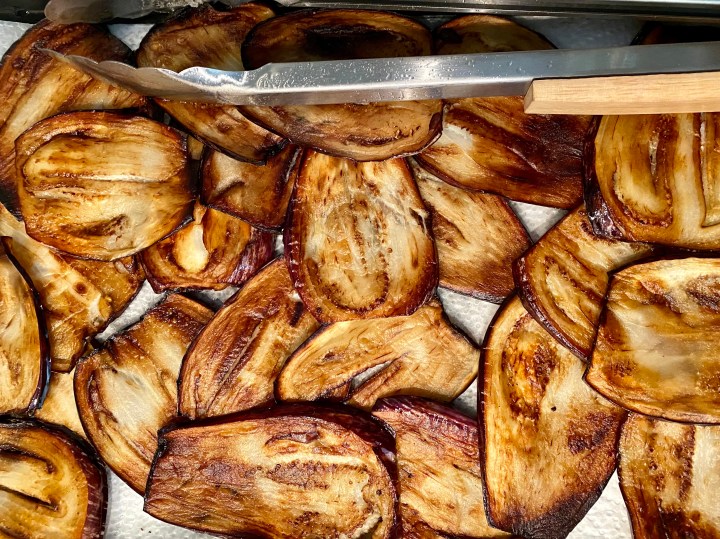
The thinly sliced and golden-fried – by Bianca – aubergines for the makloubeh batinjan. (Photo: Bianca Coleman)
Together we would spend the morning in Lindop’s home kitchen, preparing nine dishes. Later, we would all sit together at the long dining room table and share our food, drink wine – poured by Paddy who is something of an expert, delighting in providing interesting vintages and varieties – and listen to Lindop’s stories about her time and travels in Lebanon.
We donned our aprons and were assigned stations where recipes, ingredients and utensils were laid out. I began with the carrots which were to be served with a spicy harissa yoghurt, but before long I found myself busy with makloubeh batinjan, which means “aubergine dome”. It was quite relaxing to fry thin slices of aubergine while everyone else got on with their dishes. Overall we were a competent and comfortable bunch.

Makloubeh batinjan – aubergine dome with rice and lamb. (Photo: Bianca Coleman)
The next step was to make the lamb pilaf, trimming the fat from the meat. Why? I wanted to know, because I love lamb fat. Because of the richness of the dish and the oiliness of the aubergine, Lindop explained patiently.
The rice gets to simmer for a while, and by that time Paddy had arrived home and we were deep in conversation about Chenin Blanc. Lindop completed the dish, which entailed lining a bowl with the golden aubergine, then filling it and packing it firmly with the rice and lamb. Then it’s flipped over and the bowl carefully removed to reveal a gorgeous dome (see video on my Instagram) which is then scattered with toasted cashew nuts. It was by far the best dish on the table, obviously. The recipe is in Going Home, which is out of print but copies are in stock here, and I reckon I will make it again myself.

Horaa osbao – lentil dish with pita bread chips. (Photo: Bianca Coleman)
The menu included muhammara, a walnut spread with charred red peppers, of which there are many variations; khoubz (pita bread baked in a wood-fire oven); batata harra, simple carbohydrate deliciousness, also finished in the wood oven then topped with fresh garlic and coriander; samkeh harra (which means “hot”), which is fish, stuffed and spiced and baked and then smothered in tahini sauce, topped with nuts and coriander; horaa osbao, a Syrian (Lebanon was once part of Syria) lentil stew which Lindop has adapted to be a salad served with crunchy pita chips; and the aforementioned carrots.
For dessert we had shaabiyat which uses a lot of phyllo pastry brushed with a lot of ghee. This is filled with a custard called ashta, which is made with rose water and orange blossom water. After baking, they are drenched in rose and orange blossom syrup. “And when they come out of the oven you eat them and die and go to heaven,” said Lindop. Everyone laughed.
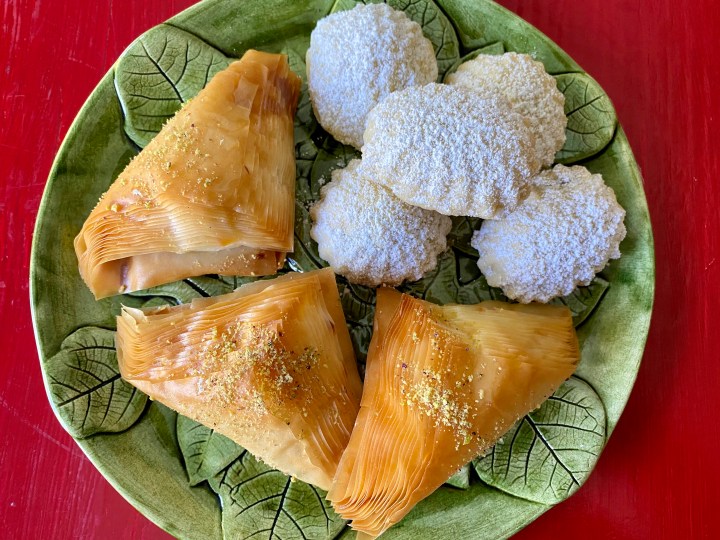
Ma’amoul and shaabiyat for dessert at Sophia’s house. (Photo: Bianca Coleman)
Finally, ma’amoul are cookies made for special occasions like Eid, Easter and Christmas. Lebanon’s population is roughly half Muslim, half Christian. The cookies are stuffed either with dates or nuts, and are made with a special wooden gadget which serves no other purpose in life. You can buy them from Lindop; she also has a small retail section with various ingredients you’ll need to continue your Lebanese cooking journey. Those who can’t get their hands on Going Home, but attend a cooking class, will, ahem, go home with printouts of the recipes of the day. These change seasonally, and also for people who attend more than once, so they get to cook different dishes.
Publisher Annake Muller still has copies available; order them at [email protected]. For more information, click here.
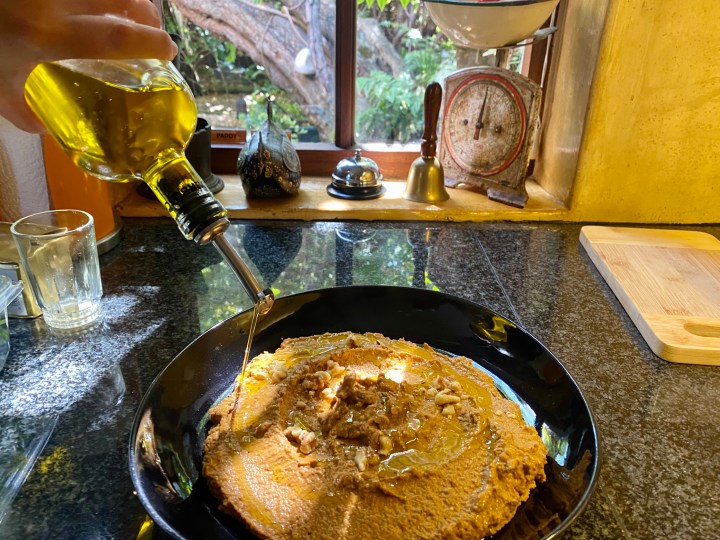
Muhammara, red pepper and walnut spread which has many variations. (Photo: Bianca Coleman)
The next stop on my personal Lebanese journey was Ghenwa’s Culinary Club at Lourensford Wine Estate in Somerset West. I met Ghenwa Steingaszner many years ago at the market at Blaauwklippen in Stellenbosch, where I sampled her delicious food for the first time. It’s taken this long to reconnect; life happens.
The venue offers a bar and a dining room for lunches and dinners, food and wine pairings, and events. A baby grand will see a jazz or classical pianist sitting at it on the last Sunday of the month. There’s also a demonstration kitchen where Steingaszner will show you how it’s done. Referring to someone as a “force of nature” means they have a strong personality or character; they might be full of energy, unstoppable, unchallengeable, unforgettable. It’s a bit of an old chestnut but it applies to Steingaszner. She literally never stops. Never. She’s always on the move, fast, always talking. “You understand me?”, she asks from time to time, and I don’t think anyone would answer “no” because there’s really no chance to interrupt the flow.
When I got there, I was given a tour of her garden; she and Lindop are both very proud of the za’atar they grow, a vital herb in Lebanese cooking. Za’atar is both the name of the za’atar oregano herb, a particularly strong variety of oregano, and the famous herb and spice mix. Steingaszner picked up some tiny peacock feathers and gave them to me. I’ve always been told they’re bad luck but Steingaszner assured me it is the opposite in her culture. On account of a small misunderstanding about times, Steingaszner was unprepared for my arrival. When I say “unprepared” I mean it very loosely. She deposited me at a table with her husband Géza, who is the wine steward with a fine cellar, and disappeared into the kitchen.
It couldn’t have been more than 20 minutes, half an hour at the most, and out came a procession of dishes which Steingaszner had whipped up. How even? Some things are best left a mystery.
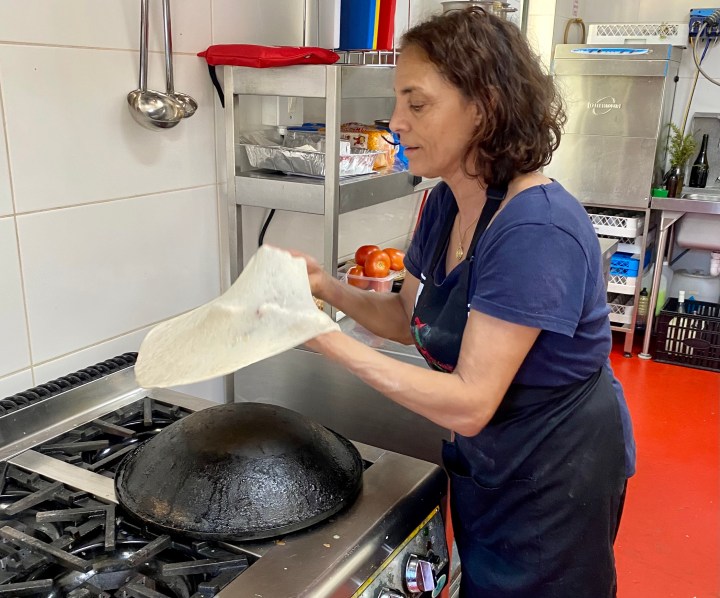
Ghenwa making her flatbread. (Photo: Bianca Coleman)
The meal is what is served for lunch and dinner – you must book – and is called The Mezze Symphony. It includes: Hummus (chickpea paste with tahini); tabouleh (seasoned parsley and chopped tomatoes salad); baba ghanoush (eggplant pure also known as aubergine caviar); muhammara (walnut and roasted peppers dip, as above at Lindop’s house, a slightly different version); falafels (deep fried chickpea balls); rakakaat (seasoned cheese rolls with parsley); lamb sambousek (pastry filled with mince and pine nuts); spinach fatayer (pastry filled with spinach, chopped onions and sumac); kibbeh akras (egg shaped lamb and bulgur mix, filled with mince and pine nuts); warak einab (stuffed grape leaves also known as dolmades but much nicer); grilled halloumi and cherry tomatoes grilled on skewer; shish taouk (free range chicken, marinated and grilled to perfection, and eaten with toumeya, a garlic paste); lamb kofta (spiced mince with parsley and onions); kibbeh nayeh, Lebanese version of steak tartare, made from lamb, minced, and mixed with bulgur wheat and spices, topped with chopped onions, mint leaves and olive oil. It’s only made on the day so if you want this, you have to order in advance, and there is a surcharge. Pickles and warm flatbread with za’atar completed this feast.
“I am not a falafel shop,” said Steingaszner. You can get a falafel meal though, and shawarmas, outside on the terrace, if you want a casual meal. Along with your mezze you’ll also get the history of Lebanese food and its stories. Like the sambousek, which has travelled around the world to become an empanada in South America, for example.
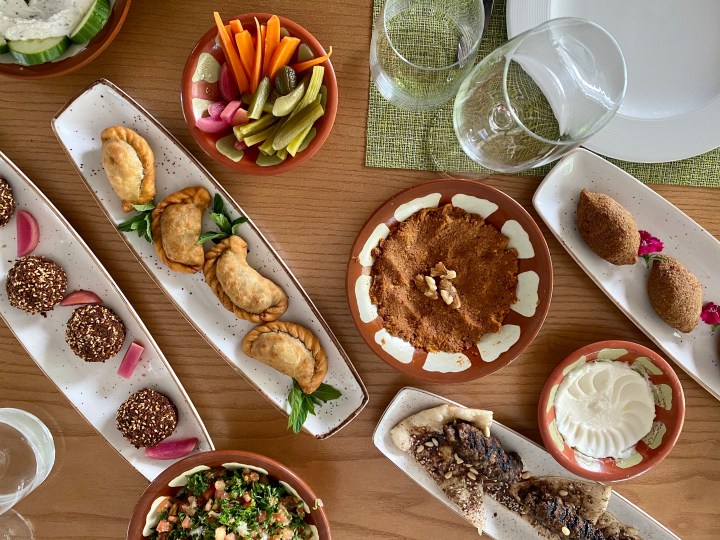
The other part of the Mezzo Symphony. (Photo: Bianca Coleman)
Before I left, Steingaszner insisted I try some pistachio ashta ice cream, and sent me off with baklawa stuffed with cashew nuts. I also had a jar of pickled turnips, another of baby aubergines from the garden, and a bottle of cordial.
For more information, click here.
Finally, I went to Lebanese Bakery & Kitchen on the corner of Imam Haron and Belvedere roads in Claremont. There I met Clara Bubenzer, who was very excited when I introduced myself and told her what I was up to with this story. “Three women! How great is that?” she said. It is indeed.
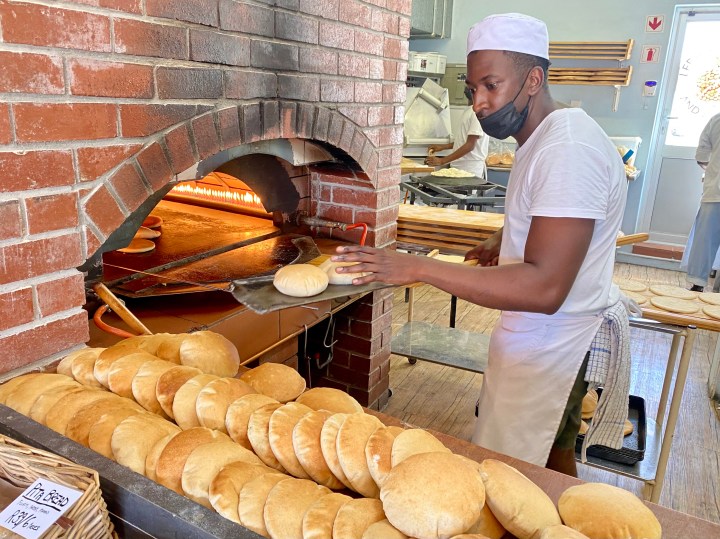
Pita bread hot from the oven at Lebanese Bakery. (Photo: Bianca Coleman)
As it says in the name, it is a bakery, but you can also get meals to eat there or take away. Plus it’s a deli and a shop stocked with pantry items. So you can get your freshly baked pita breads, a few tubs of dips and spreads, some falafel, and you’re good to go. Let these exotic words slide over your tongue – harissa, hummus, labneh, baba ghanoush, mutabal, muhammara (walnuts and peppers again), tahina, toumeya, tzatziki…
All-day breakfast is always a winner for me, and these sound tempting: Shakshuka; cheesy eggy manakish (similar to a pizza) with za’atar and harissa; scrambled eggs with onions, peppers and tomatoes in pita; Mediterranean breakfast plate with boiled eggs, rocket, tomatoes, cucumbers, olives, labneh, za’atar and pita; and for the sweet tooth, ka’ak (oval shaped bread with a hole, recipe in Lindop’s book) with jam.
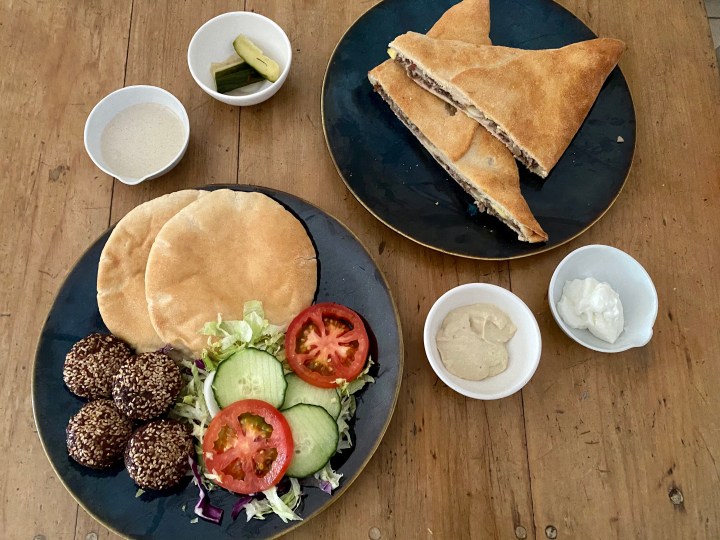
Falafel bowl and fatayer from Lebanese Bakery, taken away to have at home. (Photo: Bianca Coleman)
Even so, I ended up ordering a falafel plate – four falafel, two pita breads, hummus, toumeya, tahina, pickles, cucumbers and tomato; and a meat and cheese fatayer, a stuffed flat pie. If you don ’t know what you want, or would like to try a selection of flavours, you can order a tasting plate or a mezze platter, which are only available for sit-down dining. DM/TGIFood
For more information, click here.
The writer supports The Gift of the Givers Foundation, the largest disaster response, non-governmental organisation of African origin on the African continent.




 Become an Insider
Become an Insider
The Lebanese Bakery is one of our family”s favourite places. So happy that you have mentioned it. Wonderful food, and a happy, welcoming vibe. We love it.